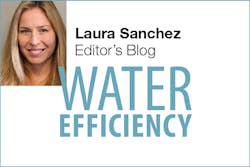Nobody wants to think about it, but all water is essentially recycled—it’s dinosaur tears, a colleague of mine likes to joke. Since most of the water that we drink each day has passed through other humans at some point before it reaches us, why are we so repelled by the concept of water reuse and terms like “toilet to tap”? A recent study examined people’s feelings about adopting recycled water.
A 2015 internet survey of 1,500 Californians revealed that only 11% of Californians indicate that they would drink recycled water. Stanford political scientists Iris Hui and Bruce Cain launched a study to better understand why.
The researchers discovered a number of fascinating results. While 87% and 86% of survey respondents indicated that they were comfortable watering their lawns and flushing toilets with recycled water, the study found that “direct consumption or skin contact with recycled water stirs the strongest resistance,” specifically drinking, bathing, and cooking with recycled water.
In general, males were more willing to use recycled water than women. Self-identified Democrats were less resistant to using recycled water than Republicans or Independents. And people living in areas adversely affected by limited water resources such as the Central Valley showed more support for recycled water, though they too balked at drinking and cooking with recycled water.
Contrary to previous research, Hui and Cain’s study discovered that the respondents’ educational level didn’t affect their views of recycled water. What did influence their perspective, however, was learning about the existence of other reuse systems, specifically the Orange County Groundwater Replenishment System’s indirect potable reuse process.
“When we give people more information about the recycled water system and how it gets purified and injected into local groundwater before being taken out for use, those details make people feel more comfortable using it in certain applications,” Hui tells Water Deeply. “The public information on this particular topic is very shallow. When you frame it differently, people react differently.”
In fact, after people were informed that Orange County has a “toilet to tap wastewater recycling program for outdoor and indoor water use, including drinking and bathing,” and that this system provides 70% of the county’s water, their willingness to drink recycled water increased from 11% to 17%. When the “toilet to tap” moniker was dropped and additional positive insight was provided about the treatment process, support for using recycled water increased further, but the share of Californians willing to drink it was still only 21%.
The study indicates that successful existing water recycling programs have a reassuring effect on people—a factor that could impact the rate of adoption. “As more communities adopt recycled water without harmful effects, the resistance to recycled water in other communities may break down over time,” write Hui and Cain.
What policy implications could these findings have in California and beyond?
